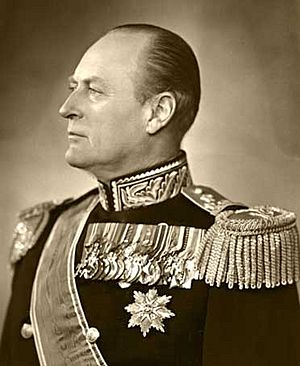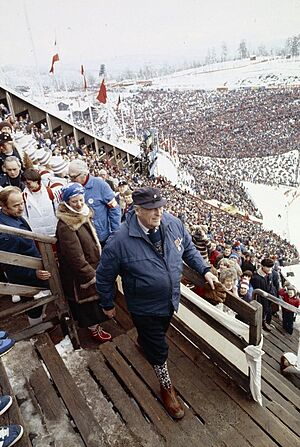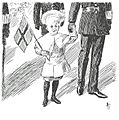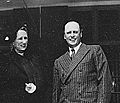Olav V of Norway facts for kids
Quick facts for kids Olav V |
|||||
|---|---|---|---|---|---|

King Olav in 1957
|
|||||
| King of Norway | |||||
| Reign | 21 September 1957 – 17 January 1991 | ||||
| Benediction | 22 June 1958 | ||||
| Predecessor | Haakon VII | ||||
| Successor | Harald V | ||||
| Prime ministers |
See list
Einar Gerhardsen
John Lyng Per Borten Trygve Bratteli Lars Korvald Odvar Nordli Gro Harlem Brundtland Kåre Willoch Jan P. Syse |
||||
| Born | Prince Alexander of Denmark 2 July 1903 Appleton House, Sandringham, Norfolk, England |
||||
| Died | 17 January 1991 (aged 87) The Royal Lodge, Holmenkollen, Oslo, Norway |
||||
| Burial | 30 January 1991 Akershus Castle, Oslo |
||||
| Spouse |
Princess Märtha of Sweden
(m. 1929; died 1954) |
||||
| Issue |
|
||||
|
|||||
| House | Glücksburg | ||||
| Father | Haakon VII of Norway | ||||
| Mother | Maud of Wales | ||||
| Medal record | ||
|---|---|---|
| Sailing | ||
| Representing |
||
| Olympic Games | ||
| Gold | 1928 Amsterdam | 6 m mixed |
| 5.5 Metre World Championships | ||
| Bronze | 1971 Seawanhaka | 5.5m |
| Bronze | 1976 Hankø | 5.5m |
Olav V (born Prince Alexander of Denmark; 2 July 1903 – 17 January 1991) was the King of Norway from 1957 until his death in 1991. He was the only child of King Haakon VII of Norway and Maud of Wales.
Olav became the heir apparent to the Norwegian throne in 1905. This happened when his father was chosen to be the King of Norway. Olav was the first heir to be raised in Norway since the 1300s. His parents made sure he had a very Norwegian upbringing. He went to both civilian and military schools to prepare for his future role. In 1929, he married his cousin, Princess Märtha of Sweden. During World War II, his leadership was highly valued. He was even named the Norwegian Chief of Defence in 1944. Olav became king after his father passed away in 1957.
King Olav was very popular because of his kind and down-to-earth personality. People called him Folkekongen, which means "The People's King". In 2005, a poll by the Norwegian Broadcasting Corporation voted Olav "Norwegian of the Century".
Contents
Early Life and Education
Olav was born Prince Alexander Edward Christian Frederik on July 2, 1903. He was born in Appleton House, located on the royal Sandringham Estate in the United Kingdom. His parents were Prince Carl of Denmark and Princess Maud of the United Kingdom. Prince Carl was the second son of Crown Prince Frederick of Denmark. Princess Maud was the youngest daughter of King Edward VII of the United Kingdom.
In 1905, Prince Carl was chosen to be the King of Norway and took the name Haakon VII. On the day of his coronation, he gave his two-year-old son the Norwegian name Olav. This name was chosen after Olaf Haakonsson, a king of Norway and Denmark from the 1300s.
Olav was the first heir to the Norwegian throne to be raised in Norway since the Middle Ages. Unlike his father, who was a naval officer, Olav chose to get his main military education in the army. He finished the three-year Norwegian Military Academy in 1924. He was one of the top students in his class. After that, Olav studied law and economics for two years at Balliol College, Oxford in England.
During the 1930s, Crown Prince Olav served as a naval cadet. He was on the training ship Olav Tryggvason. Olav moved up the ranks in the Norwegian armed forces. He started as a first lieutenant and became a captain in 1931. By 1936, he was a colonel.
He was also a talented athlete. Olav enjoyed ski jumping from the Holmenkollen ski jump in Oslo. He also competed in sailing races. He won a gold medal in sailing at the 1928 Summer Olympics in Amsterdam. He continued to be an active sailor even when he was older.
On March 21, 1929, he married his first cousin, Princess Märtha of Sweden, in Oslo. They had two daughters, Ragnhild and Astrid, and one son, Harald. During World War II, Crown Princess Märtha and their children lived in Washington, D.C. She became good friends with President Franklin D. Roosevelt. Sadly, she passed away in 1954, before Olav became king.
Role in World War II

As Crown Prince, Olav had a lot of military training. He had taken part in most major Norwegian military exercises. This made him one of the most knowledgeable Norwegian military leaders. Other Allied leaders respected his skills and knowledge. Before the war, he and his wife had become close with President Roosevelt during a visit to the United States. These connections were very important for Norway's fight against the German forces. In 1939, Crown Prince Olav was made an admiral in the Royal Norwegian Navy and a general in the Norwegian Army.
During World War II, Olav stood with his father against the German occupation of Norway. He was a valuable advisor to both civilian and military leaders. When the Norwegian government decided to go into exile, he wanted to stay in Norway. However, his offer was turned down. He reluctantly went with his father to the United Kingdom. There, he continued to advise the government-in-exile and his father. Olav helped to "build and lead a free fighting force" and made radio broadcasts from England. He visited Norwegian and Allied troops in the United Kingdom, Canada, and the United States many times. In 1944, he was appointed Norwegian Chief of Defence. After the war, he led the disarmament of the German forces in Norway. On May 13, 1945, Crown Prince Olav and five government ministers returned to a free Norway.
His war medals from other countries show how much his help in the war against Hitler was recognized. These included the War Crosses of Norway, France, Greece, and the Netherlands, the US Legion of Merit, and the French Médaille Militaire.
Becoming King and Popularity
King Haakon was injured in an accident in 1955. His son Olav served as regent, meaning he ruled in his father's place, until Haakon's death. Haakon passed away at the Royal Palace in Oslo on September 21, 1957, at 85 years old. After his father's death, Olav became King Olav V.
King Olav was known as a "People's King" and became incredibly popular. He liked to drive his own cars and would use public lanes. Even though as king he could use special lanes, he chose not to. During the 1973 energy crisis, driving was restricted. King Olav, who could have driven legally, wanted to set an example. He put on his skiing outfit and took the Holmenkollbanen suburban railway with his skis on his shoulder. When asked later why he went out without bodyguards, he famously replied that "he had 4 million bodyguards." This was about the population of Norway at the time.
For his athletic skills and role as King, Olav received the Holmenkollen medal in 1968. He also received the Medal for Outstanding Civic Achievement in 1970 and was named Name of the Year in 1975. He was very interested in military matters and took his role as Commander-in-Chief seriously. He also served as Colonel-in-Chief of the Green Howards, a British regiment named after his grandmother, Queen Alexandra.
The King traveled a lot for Norway during his reign. He made state visits to nearby countries and also to places like Ethiopia and Iran. King Olav V opened the 14th World Scout Jamboree in July 1975. Over 17,000 Scouts from 94 countries were there.
Even though the constitution said Olav had executive power, he didn't actually use it. His "duties were largely ceremonial." His actions needed to be approved by a minister, usually the Prime Minister. This minister would then be responsible for the action. He could appoint the government, but he couldn't keep a government in power if the Storting (the Norwegian parliament) didn't want it. So, his role was mostly about representing the country. Still, like his father, he had great moral authority as a symbol of Norway's unity.
Illness and Death
In the summer of 1990, the King had some health problems. He got a bit better around Christmas that year. On January 17, 1991, at 87 years old, he became ill and passed away in the evening. He died from a heart attack at the Royal Lodge Kongsseteren in Oslo. Some sources suggest that King Olav might have been very upset by the start of the first Gulf War, which began on the day he died. Olav's son, Harald V, became the next King.
On the night of his death and for several days until his funeral, Norwegians showed their sadness publicly. They lit hundreds of thousands of candles in the courtyard outside the Royal Palace in Oslo. People also left letters and cards among the candles. The National Archives has kept all these cards.
Funeral
King Olav V's state funeral was held on January 30, 1991. During the funeral procession from the Royal Palace to Oslo Cathedral, more than 100,000 people lined up along Karl Johans gate to pay their respects. Prime Minister Gro Harlem Brundtland gave a speech at the funeral. After that, the casket was moved to Akershus Fortress for a private service.
Olav was buried next to his wife, Märtha, in the green sarcophagus of the Royal Mausoleum.
Legacy and Honours
King Olav's leadership during World War II made him a symbol of Norway's independence and national unity. Since King Olav's wife, Princess Märtha, died of cancer, the King Olav V's Prize for Cancer Research was created in 1992.
In 2005, a poll by the Norwegian Broadcasting Corporation named King Olav "Norwegian of the Century".
He also received many other honours:
 Norway – A large area (Prince Olav Coast) and the Prince Olav Mountains in Antarctica are named after him.
Norway – A large area (Prince Olav Coast) and the Prince Olav Mountains in Antarctica are named after him. Norway – Olav V Land on Svalbard is named in his honour.
Norway – Olav V Land on Svalbard is named in his honour. Norway – In 1961, the King received the Nansen Refugee Award.
Norway – In 1961, the King received the Nansen Refugee Award. Norway – In 1968, he was given the Holmenkollen medal.
Norway – In 1968, he was given the Holmenkollen medal. Norway – In 2005, Olav was named the Norwegian of the Century. He received 41 percent of the votes in a popular competition held by NRK.
Norway – In 2005, Olav was named the Norwegian of the Century. He received 41 percent of the votes in a popular competition held by NRK. United Kingdom – In 1959, Olav was given the honorary rank of Air Chief Marshal in the Royal Air Force.
United Kingdom – In 1959, Olav was given the honorary rank of Air Chief Marshal in the Royal Air Force. United Kingdom – In 1958, Olav was given the honorary rank of Admiral in the Royal Navy. In 1988, he was given the honorary rank of Admiral of the Fleet.
United Kingdom – In 1958, Olav was given the honorary rank of Admiral in the Royal Navy. In 1988, he was given the honorary rank of Admiral of the Fleet. United Kingdom – He was made an Honorary Freeman of Richmond and Newcastle upon Tyne.
United Kingdom – He was made an Honorary Freeman of Richmond and Newcastle upon Tyne. South Georgia and the South Sandwich Islands – Prince Olav Harbour on South Georgia is also named after him.
South Georgia and the South Sandwich Islands – Prince Olav Harbour on South Georgia is also named after him. Skopje, SR Macedonia - In 1966, Olav became an honorary citizen.
Skopje, SR Macedonia - In 1966, Olav became an honorary citizen.
Images for kids
-
Crown Prince Olav arrives in Norway in 1905 on his father's arm and is greeted by Prime Minister Christian Michelsen
-
Haakon VII of Norway, Maud of Wales and Crown Prince Olav on 17 July 1913 in Norway
See also
 In Spanish: Olaf V de Noruega para niños
In Spanish: Olaf V de Noruega para niños










